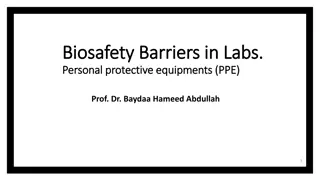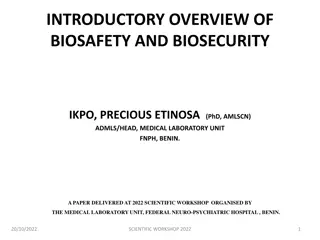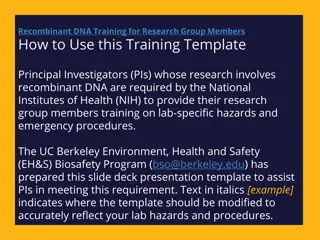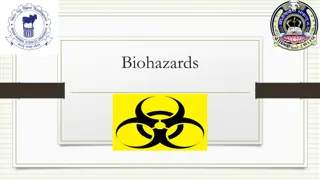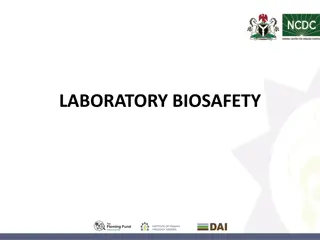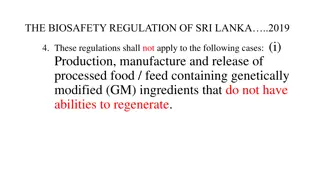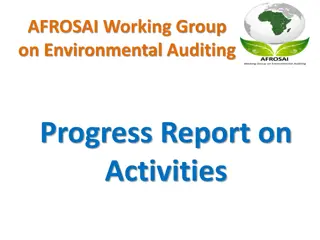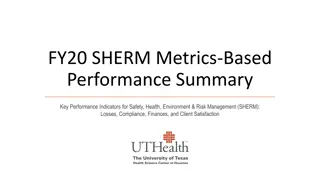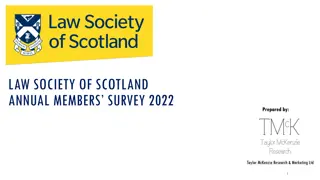Biosafety Training Requirements for Research Group Members
Principal Investigators with a Biological Use Authorization at UC Berkeley must provide lab-specific biosafety training to research group members. This training template covers CLEB administrative requirements, risk assessment, good work practices, emergency procedures, and more. Compliance ensures safe handling of biological agents in research laboratories.
Download Presentation

Please find below an Image/Link to download the presentation.
The content on the website is provided AS IS for your information and personal use only. It may not be sold, licensed, or shared on other websites without obtaining consent from the author. Download presentation by click this link. If you encounter any issues during the download, it is possible that the publisher has removed the file from their server.
E N D
Presentation Transcript
Biosafety Training for Research Group Members How to Use this Training Template Principal Investigators (PIs) who have a Biological Use Authorization (BUA) are required by UC Berkeley s Committee for Laboratory and Environmental Biosafety (CLEB) to provide their research group members training on lab-specific hazards and emergency procedures. The UC Berkeley Environment, Health and Safety (EH&S) Biosafety Program (bso@berkeley.edu) has prepared this slide deck presentation template to assist PIs in meeting this requirement. Text in italics [example] indicates where the template should be modified to accurately reflect your lab hazards and procedures.
Working with Biological Materials in the _[name of PI]_ Laboratory [Name of PI] [Name of Department] [Date Training was Last Updated]
Basic Requirements Research involving biological agents is regulated by the National Institutes of Health (NIH), Centers for Disease Control and Prevention, the US Department of Agriculture and the State of California. UC Berkeley requires a BUA approved by CLEB prior to the initiation of the experiment. CLEB works with the UC Berkeley EH&S Biosafety Program, which can provide additional guidance (bso@berkeley.edu).
Purpose of this Training UC Berkeley and CLEB require that the PI provide lab- specific biosafety training on the hazards of the specific experimental procedures used in their laboratory to members of their research group.
Contents of this Training CLEB Administrative Requirements Role of the Investigator/Lab Staff Description of the Experiment-BUA The Agents Used The Template Risk Assessment/Biosafety Level Good Work Practices Personal Protective Equipment Engineering Controls Waste Disposal/Decontamination Emergency Procedures
CLEB Administrative Requirements CLEB requires the following from every PI approved to use biological agents: Train all research group members on lab-specific hazards and procedures Report incidents involving biological agents and clinical specimens immediately to EH&S Submit a BUA amendment for any change in personnel or Scope of Work
Description of the Experiment-BUA The Scope of Work [Cut and paste scope of work narrative from your BUA]
Description of the Experiment-BUA The Agents Used [List the agents, animal cell lines, human cell lines, packaging cell lines, and human clinical specimens and animal specimens used in the experiment. Include all etiological agents.]
Description of the Experiment-BUA The Risks that May Affect Containment Level These are some of the common experimental risks associated with our research: [modify list as appropriate] Route(s) of exposure Volumes of culture Aerosol generating procedures Procedures involving sharps High concentrations The use of animals
Description of the Experiment-BUA The Risks that May Affect Containment Level These are the symptoms of exposure with the agents we use: [List symptoms of exposure]
Risk Assessment/Biosafety Level Good Work Practices [Modify list as appropriate] Wash Hands Frequently Use Personal Protective Equipment and Engineering Controls Minimize Use of Sharps Do Not Eat, Drink, or Smoke in the lab Disinfect Work Areas
Risk Assessment/Biosafety Level Personal Protective Equipment [Modify list as appropriate] The following personal protective equipment must be worn when handling agents in the tissue culture room and the biosafety cabinet: Latex or nitrile gloves Lab coat Safety glasses
Risk Assessment/Biosafety Level Engineering Controls [Modify list as appropriate] The following engineering controls must be used whenever handling agents in the tissue culture room: Biosafety cabinet Sink for hand washing Mechanical pipettes Sealed vials Sharps containers/broken glass box Eyewash/deluge shower (use only in an emergency)
Waste Disposal/Decontamination [Modify list as appropriate] Liquid waste will be treated with bleach (10% final concentration), allowed to set for 20 minutes and drain-disposed. Solid red bag wastes will be placed in a red-bag lined bin and transferred to the _________ Building, Room______ medical waste storage area for pick up & disposal. Work areas must be disinfected with 70% ethanol,10% bleach, or______________
Emergency Procedures [modify as appropriate] In the event of a laboratory accident: Tend to injured person. Seek medical attention at Tang or the Alta Bates ER at 2450 Ashby Avenue after hours. Immediately notify the PI or the lab supervisor of the incident. Initiate clean up procedures. Notify EH&S within 8 business hours of a biohazardous spill or if recombinant DNA was involved (but immediately in the event of large spills or injury): (510)-642-3073 (510)-642-3333 (After Hours)
Conclusion This training is designed to inform you of the regulatory requirements regarding use of biological materials and our lab s implementation of the campus safety requirements. All experiments with infectious agents (that may infect humans, plants, and animals) human clinical specimens, animal zoonotic specimens (NHP, sheep) require BUA approval by CLEB and any changes require an approved amendment to the BUA. I will contact the Biosafety Officer for assistance, if needed.
Training Documentation: Please keep a record of lab members who have completed this lab specific training, include: Trainee name (first, last) E-mail Signature Date of training completion First Name Last Name email: Signature Date ___@berkeley.edu


